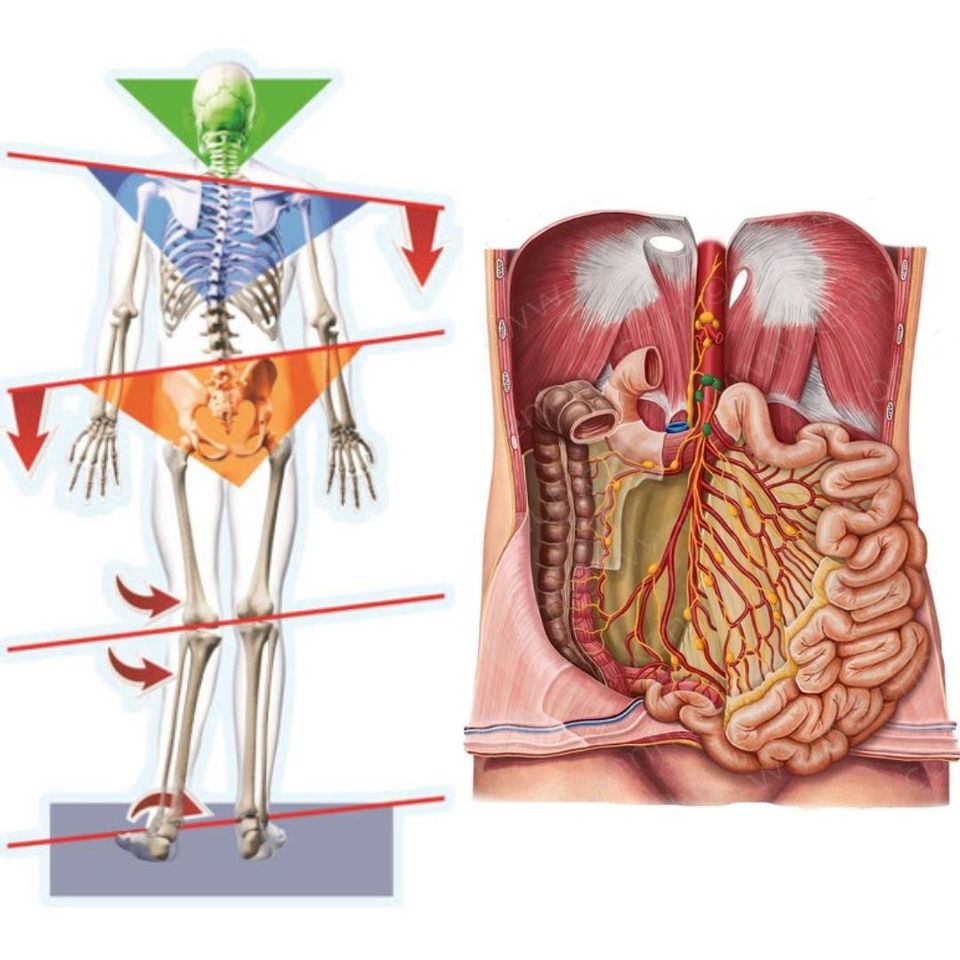THE EFFECT OF POSTURAL ALIGNMENT ON THE ABDOMINAL ORGANS

Maintaining an upright posture is essential in optimising health. While gravity pulls us down to the earths centre, ground reaction force pushes us up in opposition to the gravitational force. The balance of these opposing forces means that our bodies can easily hold themselves upright without too much effort, and this is known as physiological efficient posture(PEP). Prolonged physical or emotional stress, injury or trauma will cause allostasis ie. the body has to work much harder to restore balance and maintain the upright posture. A sports therapist will assess clients PEP by using imaginary lines and looking for various anatomical imbalances, eg. That both sides of the body look equal or that head, shoulders and hips are parallel.
HOW POSTURE AFFECTS DETOXIFICATION AND FUNCTIONING OF THE ABDOMINAL ORGANS
Toxins being excreted from the cells follow a specific route, which by passes some of the abdominal organs:-
CELL…..LYMPH…..BLOOD…..LIVER…..GALL BLADDER…..BILE…..BOWEL…..RECTUM
However, if there is a problem at any one of these stages, eg. due to postural misalignment, the toxins will accumulate and be unable to leave the cells. If this misalignment isn’t corrected, large abdominal muscles, the lats, psoas (hip flexor) and diaphragm will start to compensate for the absence of PEP. This compensation then places additional strain on the posture and the overall detoxification system, which can result in not only myofascial and mechanical dysfunctions, but also neurological. This impacts not only on the muscles and joints, but also the functioning and positioning of the diaphragm and abdominal organs, due to changes in the angle of the ribs. Pelvic tilt will further affect the position of the abdominal organs, as the pelvis supports the internal organs(viscera) . This is called visceroptosis. (Visceroptosis can also be seen in cases of Ehlers- Danlos syndrome – see posts on hEDS)
When the viscera are out of position it is more difficult for them to work together as a system and consequently this affects the detoxification process.
- LYMPH – visceroptosis causes aortic hiatus constriction which restricts thoracic lymphatic duct function, responsible for pumping lymph fluid to the heart so that it can be mixed with the blood. It is through diaphragmatic movement during breathing, that this thoracic lymphatic duct is able to move the lymph fluid, so if PEP is not maintained and deep, diaphragmatic breathing isn’t possible due to visceroptosis, the lymph flow, which is the first stage in the detoxification process, will be restricted.
- BLOOD – visceroptosis also affects the inferior vena cava and the carval hiatus of the diaphragm, which means that when we breathe in the inferior vena cava doesn’t dilate as much to allow blood flow into the atrium, and venous return will be negatively impacted on. This can result in chronic venous congestion and blood will pool in the lower limbs.
- LIVER/GALL BLADDER/ BILE – visceroptosis and any nerve disturbances , potentially also due to pelvic tilt, will affect the functioning of these organs
- BOWELS – again visceroptosis and nerve disturbances, as above, can restrict peristalsis and therefore increase the risk of constipation. Visceroptosis may also affect the tone and angle of the puborectalis muscle, which may cause problems with defecation, even if the peristaltic movement is still fairly efficient.
HOW CAN MASSAGE HELP TO RESTORE THE PEP AND AID THE DETOXIFICATION PROCESS?
• Can help restore PEP by releasing any myofascial tension, and improving the tone of weakened muscles, which in turn will increase flexibility of the joints
• By restoring PEP the abdominal organs and diaphragm return to their normal position which enables them to function more efficiently
• By correcting any pelvic tilt, massage can take any pressure off the nerves and generally calms the nervous system
• Helps to stimulate blood and lymph circulation, which will assist with cells releasing toxins
• Abdominal massage can also assist with peristaltic movement of the bowel which will further assist with the elimination process
• By restoring PEP massage helps to avoid any further compensatory measures by the muscles and joints
• By helping to restore the correct position of the ribs and the diaphragm, massage will help to improve deep breathing patterns, which improves all the body’s systems and tissues due to improved oxygen intake
